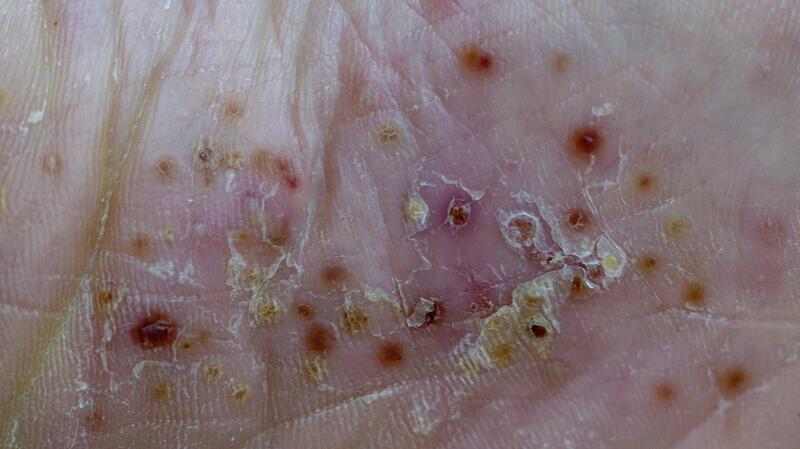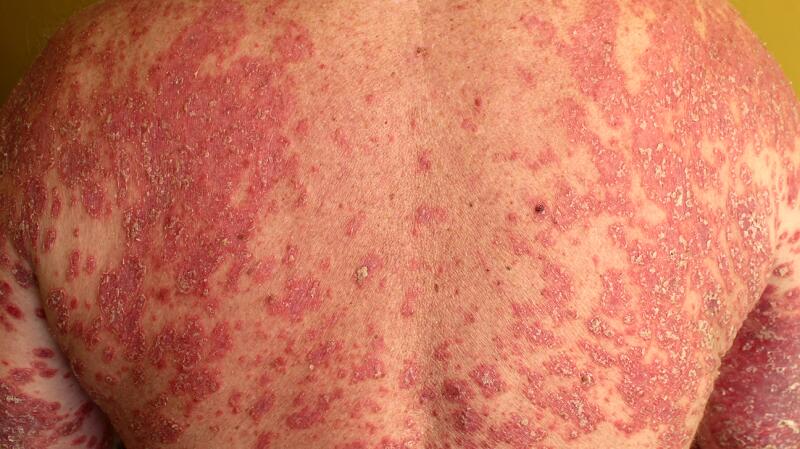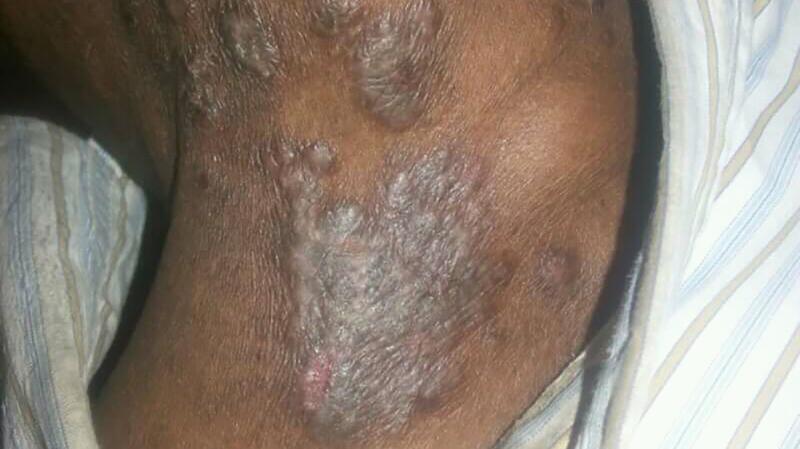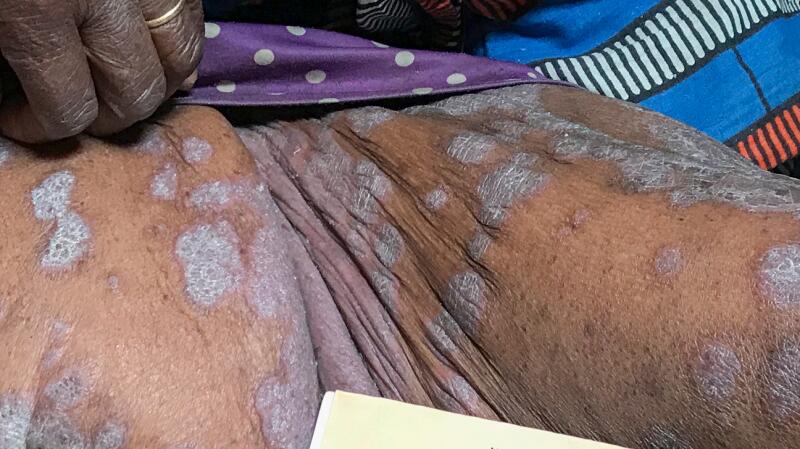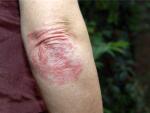This article will provide an overview of the different types of psoriasis, what they look like, and review the different types of treatment.
What is psoriasis?

Psoriasis is an autoimmune condition that causes dry, thick, and raised patches on the skin. Psoriasis affects approximately 3% of the adult population of the United States, which is more than 7.5 million people.
It is most common in adults but children can also develop psoriasis. Males and females (assigned at birth) are
Psoriasis is not contagious and you cannot catch it by touching another person’s skin.
Symptoms of psoriasis most often start between the ages of 15 and 25 years. The dysfunction in the body’s immune system causes inflammation in the body, which speeds up skin cell growth.
Normally, skin cells grow and shed within a month. However, with psoriasis, skin cells do this in only 3 or 4 days. Instead of the skin shedding, the skin piles up on the surface of the skin, causing itching, burning, and stinging.
What are the different types of psoriasis?
There are various types of psoriasis. Each type can affect the skin, nails, and joints differently.
Plaque psoriasis
This is the most common type, affecting 80–90% of people with psoriasis.
People can develop this type of psoriasis anywhere on the skin, but it typically forms on the scalp, knees, elbows, or lower back.
Guttate psoriasis
This type of psoriasis appears as small bumps on the skin that cover much of the torso, arms, and legs. This type of psoriasis tends to develop in children and young adults who have had a previous infection, such as strep throat.
Sometimes, after the first bout of guttate psoriasis, it never returns. It also is possible to have it for life or for the condition to reappear later in life.
Inverse psoriasis
This type of psoriasis typically develops where skin touches other areas of skin, such as the buttocks, armpits, or genitals.
Pustular psoriasis
This type of psoriasis usually appears on the hands and feet and causes pus-filled bumps. The bumps look like an infection, but there are no bacteria or anything else that could cause an infection inside the bumps.
The skin is typically very sore and painful. At times, it can be hard to do activities that involve your hands or feet.
Erythrodermic psoriasis
This is a serious and life threatening form of psoriasis that requires immediate medical attention.
A person with this type of psoriasis will have skin on most of the body that looks burnt, as well as chills, fever, muscle weakness, a rapid pulse, and severe itching.
If you have erythrodermic psoriasis, you may be unable to keep warm, and hypothermia can set in quickly.
Nail psoriasis
Nail psoriasis can cause tiny dents in the nails, discoloration of the nails, rough or crumbling nails, or nails that lift up from the nail bed.
About half of people with plaque psoriasis experience symptoms on their fingernails at some point.
Psoriatic arthritis
This occurs when psoriasis affects the joints, causing them to become swollen and tender. It develops in
Most people notice psoriasis on the skin before they develop psoriatic arthritis. However, it is possible to get psoriatic arthritis first.
Psoriatic arthritis is not curable but treatment can prevent it from worsening.
Read 9 things doctors want you to know about psoriasis.
What are the symptoms of psoriasis?
The most common symptom of psoriasis is skin that is dry and thick with raised patches. Other common symptoms of psoriasis include:
- pink or red patches on the skin, which may appear differently based on skin tone
- white or silvery scales
- itching
- soreness
- bleeding
- pus-filled blisters
- hair loss
- tiny dents or pits in the nails
- nail discoloration
In severe cases, psoriasis can cause fever, chills, rapid heart rate, weight loss, and fatigue. If you experience any of these symptoms, get medical attention right away.
What does psoriasis look like?
Each type of psoriasis looks slightly different.
- Plaque psoriasis: This involves patches of different sizes of thick, raised skin with a dry, thin, and silvery-white coating.
- Guttate psoriasis: This appears as tiny bumps that are small and scaly and salmon-colored to pink.
- Inverse psoriasis: This involves smooth, red patches of raw-looking skin, little or no silvery-white coating, and sore or painful skin.
- Pustular psoriasis: This appears a red, swollen skin that contains pus-filled bumps with brown dots that appear as the bumps dry. The skin is extremely sore or painful.
- Erythrodermic psoriasis: The skin on most of the body appears burnt. Chills, fever, muscle weakness, rapid pulse, and severe itching can occur.
- Nail psoriasis: This includes tiny dents, or pits, in the nails, as well as white, yellow, or brown nail discoloration. It can also lead to crumbling nails, rough nails, and nails that lift up.
- Psoriatic arthritis: This involves swollen and tender joints, especially in the fingers and toes. Heel pain may also occur, alongside swelling on the back of the leg, just above the heel. You might also experience joint stiffness in the morning that fades as the day goes on.
What causes psoriasis?
Researchers do not know what exactly causes psoriasis, but they think it may be due to a problem with the immune system.
Your immune system is the body’s main source of defense that helps fight infection. One of the cells that plays a major role in fighting infection is the T cell.
T cells normally travel throughout the body and detect and fight against foreign bodies such as bacteria. However, in people with psoriasis, the T cells start to attack healthy skin cells by mistake. This causes the skin to produce new skin cells more quickly than usual, triggering the immune system to make more T cells.
Genetics also plays a role in the development of psoriasis, and you are more likely to get it if you have a close relative with the condition. Research has shown that it is likely a combination of numerous different genes that makes people more vulnerable to psoriasis.
What are the risk factors for psoriasis?
People with certain medical conditions and triggers are more likely to develop psoriasis than other people. However, not all people with risk factors will go on to develop psoriasis.
Certain triggers can also make symptoms worse or more frequent. These periods are called flares. Some common triggers for psoriasis flares include:
- skin injuries, such as cuts or scrapes
- air pollution or sun exposure
- certain medications
- recent infections
- smoking
- alcohol use
Certain conditions are also risk factors for developing psoriasis or can make psoriasis symptoms more severe. These include:
- metabolic syndrome
- obesity
- diabetes
- high cholesterol
- high blood pressure
- mental or emotional stress
- other immune disorders
Reducing your risk of psoriasis outbreaks
You can reduce your risk of psoriasis outbreaks by living a healthy lifestyle and taking care of your skin. If you have chronic conditions such as high blood pressure or diabetes, work with your doctor to develop and follow an effective treatment plan.
Eating well and exercising can reduce the likelihood that you become overweight, have obesity, or develop metabolic syndrome, all of which are risk factors for developing psoriasis. If you smoke or drink excessive amounts of alcohol, decreasing your use can help lower your risk of flares.
What are the treatments for psoriasis?
Treatment for psoriasis consists of oral and topical prescription medications, at-home treatments, lifestyle changes, and systemic therapy.
Medications to treat psoriasis
Medications for psoriasis may be oral, injectable, or topical depending on the severity of your symptoms.
Topical treatments are usually the first line of treatment for mild to moderate psoriasis and can take up to 6 weeks to take effect. Some examples of topical medications doctors use to treat psoriasis include:
- emollients
- topical steroids
- vitamin D analogs
- calcineurin inhibitors
- coal tar
- dithranol
If your psoriasis is severe and topical medication has not been effective, your doctor may prescribe systemic treatments. Systemic treatments are either non-biological or biological.
Examples of non-biological medications include:
- methotrexate
- cyclosporin
- acitretin
- apremilast
Examples of biological medications include:
- etanercept
- adalimumab
- infliximab
- ustekinumab
At-home treatment for psoriasis symptoms
People with psoriasis should follow a gentle skin care routine using mild soaps made for people with sensitive skin. Some people with psoriasis and psoriatic arthritis have found an improvement in symptoms by getting acupuncture and massage with essential oils. People with psoriatic arthritis may also benefit from physical therapy and rehabilitation.
Some other natural remedies for people with psoriasis include:
- aloe vera gel
- apple cider vinegar
- capsaicin creams or ointments
- dead sea salts
- oat baths
- tea tree oil
- turmeric supplements
- mahonia aquifolium cream
These types of treatments are potentially irritating, so use them with care. Speak with your doctor if you have any questions or concerns.
Learn more about home remedies and alternative treatments for psoriasis.
Lifestyle changes and general treatments for psoriasis
People with psoriasis benefit from living a healthy lifestyle such as eating a balanced diet, exercising, managing chronic conditions, and managing stress and other triggers.
If your psoriasis is severe or has not responded well to topical medications, your doctor may recommend you try phototherapy treatment. Phototherapy uses both natural and artificial light to help treat psoriasis and is different from a tanning bed.
Two types of phototherapy your doctor may use include:
- UVB phototherapy: This type of light slows down the production of skin cells and only takes a few minutes. You may need to go to the hospital for sessions two to three times a week for 6–8 weeks.
- Psoralen plus UVB: This type of treatment first uses an oral tablet containing compounds called psoralens, or the compound may be applied directly on the skin. This type of light penetrates more deeply than UVB light but should not be used long term, as it can increase your risk of skin cancer.
Other frequently asked questions
Here are some more questions people often ask about psoriasis. Raechele Gathers, M.D., has reviewed the answers.
Can stress cause psoriasis?
While stress is not a direct cause of psoriasis, it is a trigger for a flare-up in someone who already has psoriasis.
What is the life expectancy for someone with psoriasis?
Life expectancy in people with psoriasis is lower than people without the disease. Some studies suggest that psoriasis shortens the life span by 4 years and possibly up to 10 years. However, knowing and managing triggers can help prevent relapses of psoriasis.
Summary
Psoriasis is an autoimmune condition affecting the skin. The most common symptoms are thick, dry skin with raised patches. Sometimes the patches have a white-silvery coating called scales.
Psoriasis is most common in adults and affects males and females (assigned at birth) equally.
Certain risk factors can trigger episodes of psoriasis, such as sun exposure, taking certain medications, stress, and smoking. There is no way to prevent psoriasis, but people with the condition can learn how to manage their triggers. Treatment for psoriasis includes medications, at-home remedies, and lifestyle modifications.

